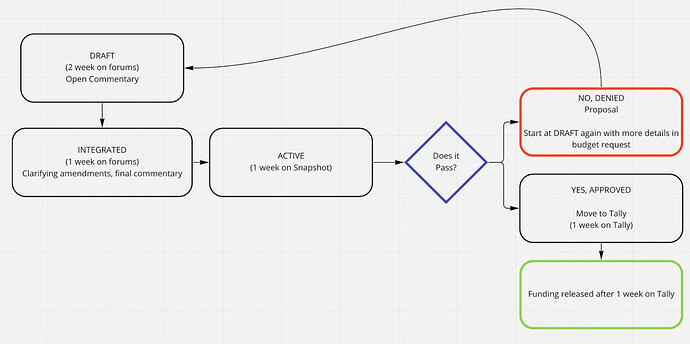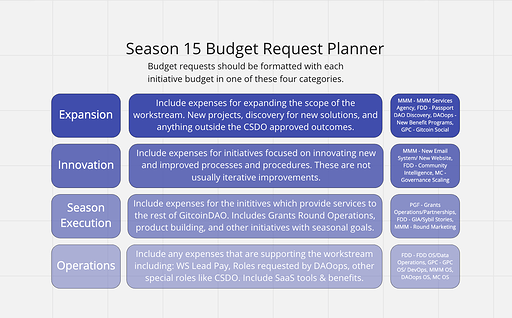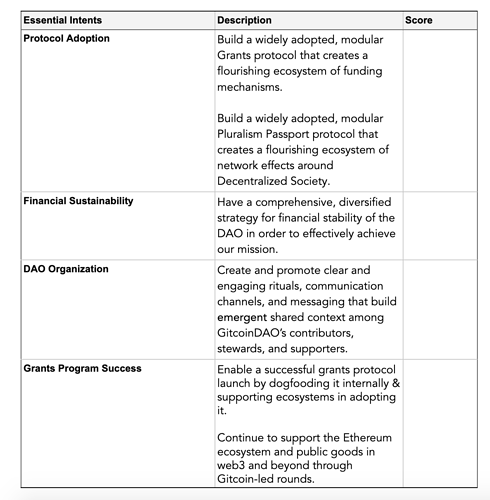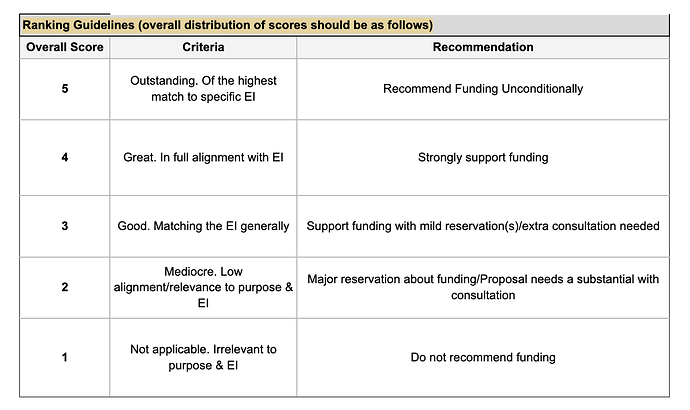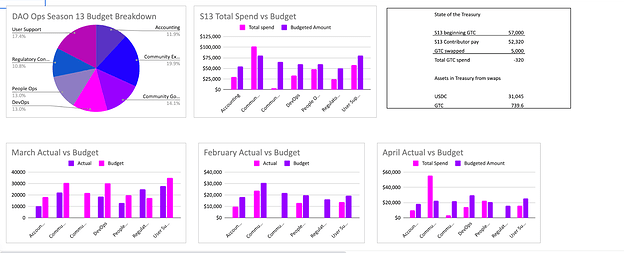Original Accountability flow Jan 2022
Tl;dr
- Reasoning behind rework of the flow
- New format
- Consultation
- Evaluation
- Timeline S15
Summary
This proposal seeks to amend, improve and standardize the budget proposal process for Gitcoin DAO following extensive feedback across the steward council, the steward circle and workstream leads/contributors. The purpose of this revision of the accountability flow is to integrate the lessons learnt in S14 and ensure the new budget proposal process delivers the most value, alignment and collaborative consensus across the DAO. It is designed to ensure that any funding requested by workstreams is in service of and in line with the Purpose and Essential Intents of the DAO, improving transparency, accountability and accessibility when it comes to proposal review processes.
Motivation
A process to uncover, refine and define the purpose of Gitcoin DAO became a necessity as discussions around what should and should not be funded in S14 started to intensify. It became very apparent that any budget request must be made in alignment and with direct contribution to the purpose of the DAO.
As a constantly iterating and innovating force in the web3 ecosystem, improving the accessibility and transparency of DAO flows is the next level in better coordination. For our DAO ecosystem to flourish, it requires a mindful effort to improve on current tooling and to support better ways for DAOs at large to enable governance engagement and accountability across the board.
Current proposal framework
Proposals currently vary broadly in their stated goals, format and monetary requests.
This v2 of the Accountability flow aims to establish a better standard template to facilitate review and discussion. It aims to take the alignment started in the run-up to S14 and bring all Gitcoin DAO activity around a clear, transparent, quarterly dynamic for better alignment, contribution and transparency across the organism.
New budget proposal framework
As observed in S14, most of the proposals ended up being amended at least once so a better distinction between stages should make the process far clearer. All budget proposals should follow the following format & flow.
STAGES:
1. The first stage of a budget proposal will be a DRAFT
- the draft proposal will be posted on the forum showing [DRAFT] in the title and shared in the first steward call of the new season (ex. [DRAFT] Public Goods Funding budget request)
- the DRAFT proposal will then enter a period of consultation lasting two weeks. Feedback and discussion will happen both on the forum and in the stewards council call and should involve input from the community, stewards, the council and other workstreams. Workstream feedback is highly encouraged at this stage as cross-stream support could become a key piece of the evaluation flow.
2. The second stage of a budget proposal will be INTEGRATED
- Any feedback from the steward calls and the DRAFT post will be integrated in this proposal and published to the forum - this is to ensure clarity in amendments, changes and evolution
- this stage can be on the forum for one week
3. The third stage will be ACTIVE
- a proposal will move to ACTIVE after the consultation period ends and all feedback is integrated. This ACTIVE proposal will be setup directly on Snapshot and be setup with the following format:
- [WORKSTREAM] S# Budget Request
- Full amount - GTC and USDC Equivalent
- Tl;dr - one paragraph
- Main season objectives
- Link to INTEGRATED DRAFT for all info
The Snapshot will be live for a period of five days.
4. The fourth and final stage will be RATIFIED
- a proposal is RATIFIED once it reaches Tally and the funds are moved into the multisigs
- ANY proposal moving into a Tally should PASS. All decisions on yes/no are made in the ACTIVE Snapshot phase.
- Format: XXX workstream S# funding request ratification
The Tally vote will be live for a period of five days.
5. The fifth potential stage - should a proposal be “denied”
- In the event of a proposal being denied, a new proposal can be created using the following template. The purpose of the template is to create a clear delineation between maintaining status quo only (current operations and fulfilling OKRs for the season vs any expansion)
FORMAT:
- Which EI (Essential Intent) is the WS in alignment with (ratified current version here)
- A tl;dr section at the top of the proposal summarizing the main focus for the season.This is for increased transparency and a smoother decision making process.
- A milestone report containing goals achieved during the previous quarter. The milestone report should include:
- who are the current contributors (marked as FT or PT)
- funds spent to date/season & overall
- any funds carrying over to the next quarter
- notable achievements for the quarter
- Proposal body
- Mentioning initiatives, objectives, and metrics
- Budget breakdown
Example Proposal Template:
EI
Add the Essential Intent(s) respective Workstream is focused on.
TL;DR
Text section goes here.
Amount
State budget ask in GTC & USD equivalent. This section should include the following note:
The GTC total will be adjusted based on the current market value at the time this proposal is moved to Tally. The vote will be to send the requested $USD amount in GTC at the lower of the current price or the 20 day moving average, whichever is lower.
Milestone Report
Initiative/Dept Objectives Past Season Value Delivered
Proposal Body
Focus on essential work for season you are requesting budget for ONLY
Initiative/Dept EI Objective Current Season Key Results
Budget Breakdown
Budget Category
(Dept/team) Goal/OKR relevant to EI for season requested Amount GTC Amount USD
- Visual breakdown (this will be created by @ChrisDean in collaboration with each workstream - an automation/templating of this endeavour will hopefully be in place by S16)
CONSULTATION:
The consultation, evaluation and ratification period for proposals is to be extended from the cadence of ~15 days experienced in S14 (and before) to a longer process as of season 16. This means that DRAFTS would be presented at least one to two months before the end of the previous season.
This is to enable ample discussion, feedback sessions and engagement across the decision making apparatus.
Types of discussion:
Workstream: xx
CSDO: xx
Forum: Comments and feedback should be recorded on the forum as in previous seasons
Stewards Call: a space for discussion involving the stewards - this will involve the steward/workstream allocation we discussed for better insight
Steward Council Call: a space for strategic discussion amongst council members to address any pressing or problematic requests
EVALUATION:
*NOTE: not all WS will match ALL EIs
*Any budget request scoring under 4 average across stewards/community may need to revise budget request
Financial Evaluation:
A visual report of the budgets for all WS against the treasury will be provided and WS will have it accessible to include in their proposals. A more complex forecasting report could evolve from here where we genuinely look at short | medium | long term.
Timeline
Key dates for upcoming season (S15) :
07/25-08/08 - Review DRAFT proposals
08/08 - INTEGRATED proposals on forum
08/15 - FINAL proposals on snapshot
08/22 - FINAL proposals on tally
S16 learning & dates coming up in v3
